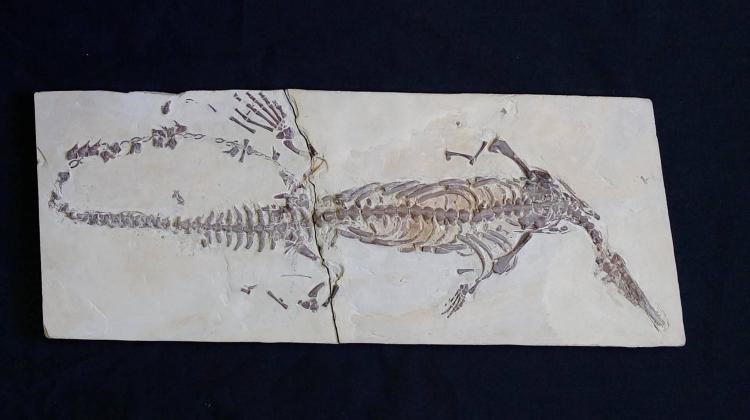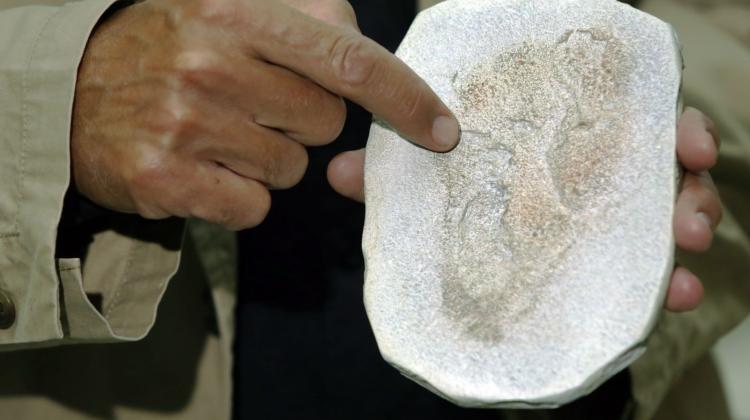148 million years old remains of a sea turtle discovered in Łódź provinc
 An artist's impression of the newly described turtle species: Owadowii borsukbialynickae. Credit: Tomasz Szczygielski
An artist's impression of the newly described turtle species: Owadowii borsukbialynickae. Credit: Tomasz Szczygielski
148 million years old remains of a sea turtle have been discovered by paleontologists in the quarry Owadów-Brzezinki (Łódź province). The discovery helps to better understand the evolution of these animals and their adaptation to the environment.
The turtle from Owadów resembled today\'s sea turtles. Its shell reached a length of about 40 cm - slightly less than its today\'s relatives. The name of the new species of turtle - Owadowia borsukbialynickae - refers to the paleontological site Owadów-Brzezinki and the name of Prof. Magdalena Borsuk-Białynicka, accomplished researcher specialising in Mesozoic reptiles.
"This is the oldest known turtle adapted strictly to sea food" emphasised Daniel Tyborowski from the Museum and the Institute of Zoology PAS, one of the authors of the article describing the animal. The publication appeared in the prestigious "Geological Journal". Co-authors are Tomasz Szczygielski and Dr. Błażej Błażejowski from the Institute of Paleobiology PAS.
Tyborowski added that this is a key discovery for understanding the evolution of sea turtles.
Researchers also point out that 148 million years old remains of turtles are very rare in our part of Europe. Most of the previously known discoveries of this type have been made in Western Europe, Germany or Switzerland. However, this time a previously unknown species of turtle has been discovered in Poland - noted Tomasz Szczygielski.
The only parts of the turtle that survived to our time are the lower jaw, the femur, fragments of the pelvis and shoulder.
The construction of the jaw, a large part of which is the crushing surface, indicates adaptation to the marine environment. "Its size indicates that the turtle used its jaws, and actually its +beak+, to crush shelled invertebrates such as molluscs and crustaceans, which are marine organisms" - noted Tyborowski. According to him, the find is 148 million years old - which means that it comes from the end of the Jurassic period. It is several million years older than previously discovered remains of sea turtles similarly adapted to marine life.
"The feet of today\'s turtles are basically shaped like wings, and the turtles\' movement resembles an underwater flight. Owadowia probably could not do something like this yet, but its feet were probably partially webbed" - said Szczygielski.
148 million years ago the area of present-day Poland resembled today\'s Caribbean - there was a warm, shallow sea with thousands of islands and islets, where many tropical animals lived.
The fossilized remains of the turtle will be on display in Geopark Sławno, which is being built near the quarry. Its opening is scheduled for August 2018.
the quarry Owadów-Brzezinki is located in the northern part of the Świętokrzyskie Mountains. It is one of the most unique and rich palaeontological sites discovered in recent years in the world. So far, scientists have discovered the remains of Poland\'s first known flying reptile - pterosaur and a new species of marine reptile, ichthyosaur.
PAP - Science and Scholarship in Poland, Szymon Zdziebłowski
szz/ zan/ kap/
tr. RL
Przed dodaniem komentarza prosimy o zapoznanie z Regulaminem forum serwisu Nauka w Polsce.


















